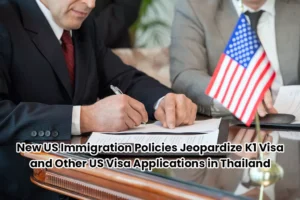For many Thai citizens dreaming of a new life in the U.S. with their American spouses, understanding the fastest and most efficient way to make this dream a reality is very important. Reuniting with one another is a journey that can be filled with anticipation and questions, particularly about figuring out the complex nature of the immigration processes.
Two common examples are the K-3 visa and the I-130 petition. Each of these options offers a different route with its own set of procedures, timelines, and requirements. This article aims to shed light on these two pathways while providing clear and concise information to help applicants make an informed decision, focusing particularly on which option might bring couples together more quickly. Whether you’re just starting to plan your journey or are in the midst of it all, understanding these options will facilitate your journey to a new life in the U.S.
What is the K3 Visa?
The K-3 visa is a non-immigrant visa designed for Thai spouses of American citizens. This visa category is specifically tailored to lower the wait time and emotional strain caused by the physical separation of transnational couples. It allows the Thai spouse to enter the USA and live with their American partner while their immigrant visa (I-130) is being processed. The K-3 visa is viewed as a beacon of hope, providing a way for couples to build their life together in the U.S. sooner rather than later. The primary aim of this visa is to minimise the time couples spend apart, thereby easing the transition period and fostering a smoother integration into life in the USA.
Understanding the I-130 Petition
On the other hand, the I-130 petition represents a more direct and enduring route towards family reunification. It is essentially a formal request for an immigrant visa, initiated and filed by the U.S. citizen spouse. This petition is the foundational step in the journey towards securing lawful permanent residency, commonly known as a Green Card, for the Thai spouse. Unlike applying for the K-3 visa initially, which is seen as a temporary measure, directly applying for the I-130 stands as a steadfast path to permanent residency. It symbolises a long-term commitment and a future in America, offering stability and alleviates concerns for the couple. The I-130 process, while potentially longer, culminates in the Thai spouse successfully obtaining the rights and privileges of a permanent resident, a significant milestone in the lives of many international couples.
Comparing Speed: The K-3 Visa vs the I-130 Petition
The key question is: Is the K-3 visa faster than the I-130 petition? The answer isn’t straightforward. Historically, the K-3 visa was indeed a quicker route. However, changes in processing times and policies have blurred this difference.
- Processing Times: The processing times for both the K-3 visa and the I-130 petition can vary significantly based on several factors, including the workload of the U.S. Citizenship and Immigration Services (USCIS) and the specific circumstances of the applicant.
- Changes in Policy: In recent years, the USCIS has made efforts to reduce the processing time for I-130 petitions. This change means that in some cases, the I-130 can be as fast, if not faster, than the K-3 visa.
- Case-by-Case Basis: Each application is unique. Factors like the completeness of your application, the need for additional evidence, and the specific details of your case can affect the overall timeline.
Advantages and Disadvantages of Each Path
Choosing between the K-3 visa and the I-130 isn’t just about speed. There are other factors to consider:
- K-3 Visa Advantages: The K-3 visa allows the Thai spouse to be with their American partner sooner, offering a temporary solution while waiting for the I-130 processing.
- K-3 Visa Disadvantages: It’s a temporary visa and requires adjustment of status once in the USA, which means additional paperwork and potential costs.
- I-130 Advantages: It’s a direct path to permanent residency. Once approved, the Thai spouse can enter the USA as a permanent resident.
- I-130 Disadvantages: It might involve a longer waiting period before the Thai spouse can join their American partner in the USA.
Conclusion
While the speed of the K-3 visa can be appealing, especially for couples eager to reduce their time apart, the I-130 petition often emerges as the more advantageous choice in the long run. This is particularly true considering the evolving processing times and the enduring benefits that come with the I-130. For Thai couples looking towards a stable and secure future in the U.S., the I-130 not only symbolises a commitment to a shared life but also paves a clear path to permanent residency. This route, despite potentially longer waiting times, offers a sense of permanence and security that the temporary K-3 visa cannot match.
Moreover, the I-130 process, once completed, eliminates the need for further adjustments of status, thereby reducing the complexity and potential additional costs associated with transitioning from a non-immigrant to an immigrant status. It’s important for Thai couples to weigh these long-term benefits against the immediate but temporary relief offered by the K-3 visa.
Consulting with an immigration expert is highly recommended to navigate these options effectively. They can provide tailored advice, taking into account your specific circumstances and priorities. Remember, the journey to reunite in the U.S. is a significant step. Patience, informed decision-making, and careful planning will pave the way for a successful and stable transition to your new life together. Embracing the I-130 petition could be the key to a more secure and fulfilling future in the U.S. for many Thai-American couples.
Contact Siam Legal
 | Ken Graham US Immigration Attorney Partner, Siam Legal International |
 | Natdaphon Luengsawang Senior US Visa Consultant Siam Legal International |
LIVE SUPPORT
 CALLCall (702) 799 9719 |  CHATChat with our representative | |
| From US: Sunday – Friday 5:00 PM – 7:00 AM (New York time) 2:00 PM – 4:00 AM (Los Angeles time) From Thailand: Monday – Friday | ||








































